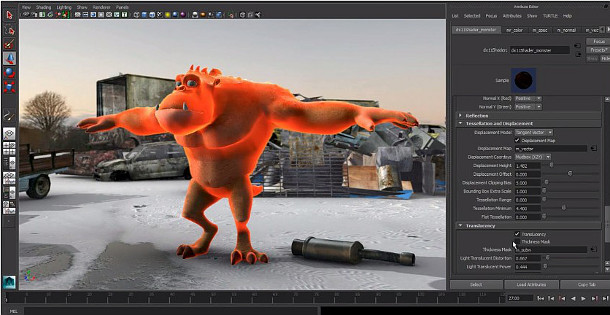Autodesk announces new features of Maya 2014
Autodesk has announced the new features of Maya 2014 in the run up to tomorrow’s live Unfold event.
Of the new tools, arguably the ones that most Maya users will use most often are the new modelling options, which are derived from digitalRaster’s NEX plugin.
Autodesk previewed some of these in a sneak peek video, which showed the new Quad Draw tool in use to retopologise a character.
However, a lot of other digitalRaster tools have been added, including new Bevel, Bridge and Connect options, and a useful-looking Multi-Cut tool for creating edge loops more quickly.
There is an improved mesh-decimation algorithm, with options to apply a given percentage reduction in poly count, or to achieve a given vertex or triangle count; and to do so on a per-component basis.
Selection options have been increased, with options to store vertex, edge and face selections simultaneously; while middle-mouse-dragging lets you tweak the positions of vertices or edges without making a selection first.
The video at the top of the story also shows a number of other new tools, and is worth watching in full.
Layout artists also get the benefit of the new scene assembly options, which are designed to enable users to manage very large scenes, toggling between display levels on the fly.
The workflow is based around two new types of node: Assembly Definition and Assembly Reference.
Assembly Definition nodes act as containers for different representations of an object, ranging from fully textured geometry; through a lighter, non-editable GPU Cache; to a simple locator.
Further control over level of detail can be achieved via the Convert Geometry to Bounding Box options.
Artists can set the default display level for each Assembly Definition individually; or toggle between levels via the Outliner, Attribute Editor, or by right-clicking in the viewport.
Assembly Definitions can then be linked via Assembly References, creating lightweight, easily navigable representations of complex scenes: the video above shows a 70kb file that represents a 3.5GB dataset.
Also aimed at managing complex scenes, the new File Path Editor helps diagnose and fix unresolved file paths to external assets, including textures, references, audio nodes and image planes.
The Paint Effects toolset receives its first update in a while, with new options to control how Paint Effects strokes react with surfaces, volumes or one another.
Surrounding meshes can be set up as collision geometry or given a Surface Attract value: for example, to cause objects to displace or attract Paint Effects vegetation.
Artists also get more control over the way vegetation flows over a surface via new Occupation Surface options and a Surface Snap checkbox, creating more realistic-looking results.
Character artists get a Snap To Projected Center option for the Joint Tool, which finds the centre of the body part being rigged: a user can place joints in the Top view and have Maya position them automatically on the Y-axis.
Like 3ds Max 2014, Maya’s viewport now supports DirectX 11, enabling a range of advanced display options, and exposing DirectX 11 natively to Maya.
The update lets games artists see their assets in context via the new Maya ‘ubershader’: an HLSL shader that supports many attributes of current-gen games, including vector displacement and real-time reflections.
The video for this one isn’t embeddable, but you can watch the whole thing here.
The Node Editor has been enhanced to enable “nodes to be edited in a more intuitive environment … reducing dependency on the Connection Editor”.
This one gets quite in-depth, and you probably already know whether you’re likely to warm to the new features, so check out the video above if you want more details.
New brand identity
Maya also gets a new ‘origami-inspired’ logo, which you can see in the homepage image for this story. The new identity is part of a company-wide revamp, bringing all of Autodesk’s product logos in line with one another.
The animation tools, including 3ds Max, Maya, Softimage and MotionBuilder, also get new brand graphics in aqua and white, described by Autodesk as an abstract “visual representation of movement”.
Release date and pricing
Maya 2014 is due to ship on 12 April. According to UK distributor bluegfx, the price of a seat is set to rise by just over 10%, from £2,900 to £3,200.
As yet, we aren’t certain if the same applies outside the UK, but it seems less likely: the North American SRP of Maya rose by 5% last summer, from $3,495 to $3,675.

